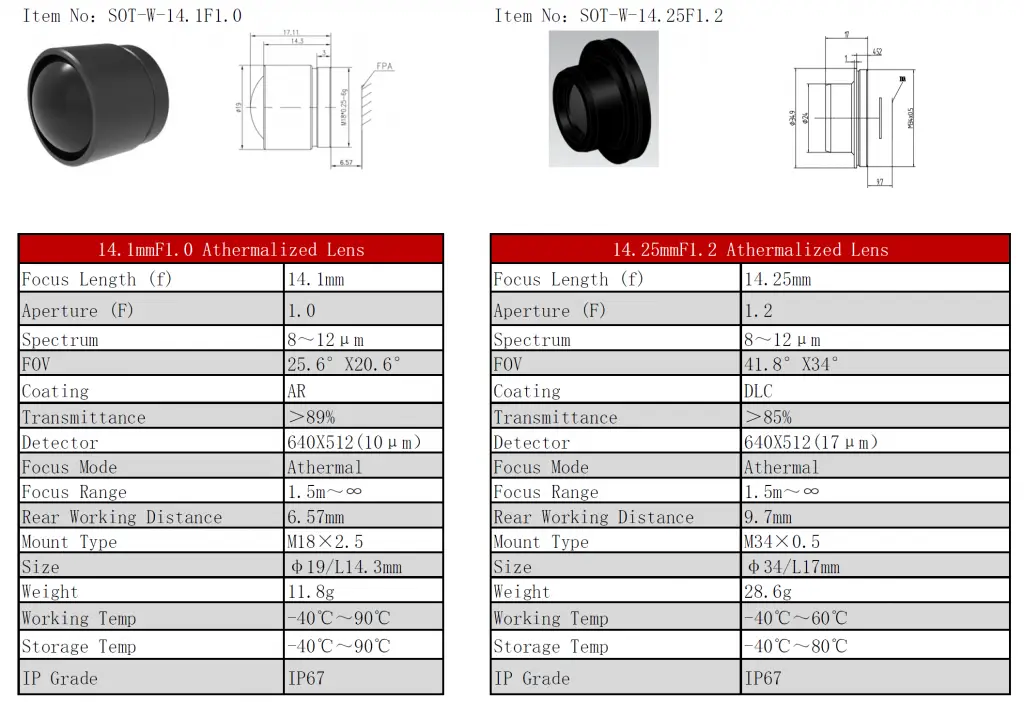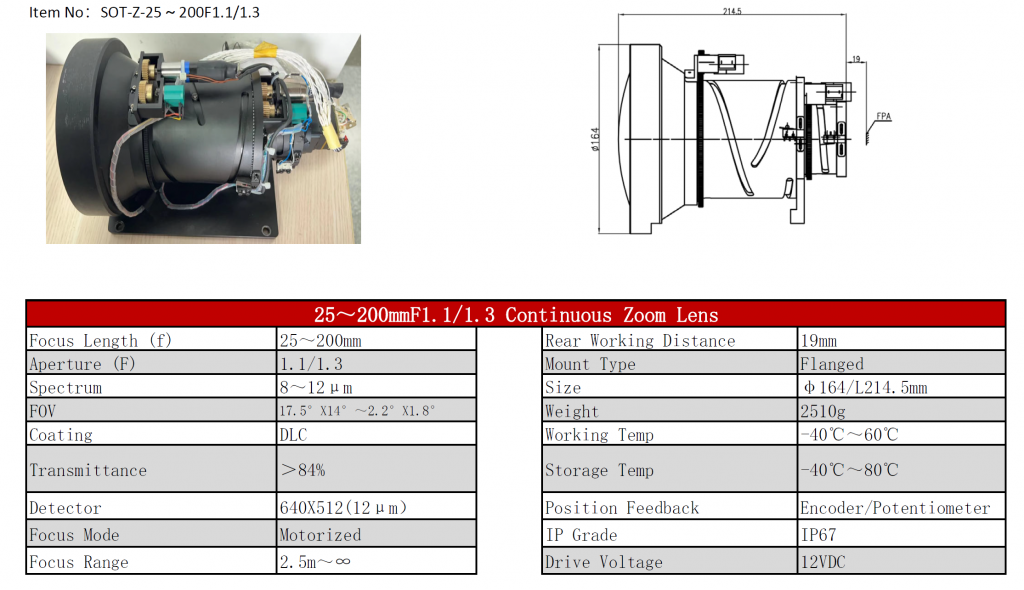Description: Uncooled Long-Wave Infrared (LWIR) lenses are designed for thermal imaging in the 8-14 µm wavelength range. These lenses are used with uncooled infrared detectors, which do not require cryogenic cooling, making the systems less complex and more cost-effective.

Optical Module Characteristics: These lenses are typically made from materials like Germanium, which have high transmittance in the LWIR range. They are rugged and designed to perform in varying environmental conditions without the need for cooling.
Key Optical Parameters:
- Focal Length: Varies with the application, commonly in the range of 25mm to 100mm.
- Aperture: Often wide to allow more infrared light, improving the detector’s ability to capture thermal images in lower light conditions.
- Spectrum FOC: Specifically tuned for the 8-14 µm range.
- Transmittance: Optimized for high transmittance in the LWIR spectrum.
- Detector Compatibility: Compatible with various types of uncooled bolometric or pyroelectric detectors.
- Mount Type: Standard mounts like C-mount or custom mounts depending on the camera system.
Applications: Commonly used in building inspections, HVAC system evaluations, automotive night vision, and general surveillance where high sensitivity is not as crucial but cost and robustness are.
Selecting an uncooled Long-Wave Infrared (LWIR) lens involves considering factors that align with your specific application needs, just like with cooled systems, but with some distinctions due to the nature of uncooled detectors. Here’s a guide on choosing the right uncooled LWIR lens:
- Application Requirements: Determine the primary use of the lens, whether it’s for industrial, security, medical imaging, or environmental monitoring. Uncooled LWIR lenses are popular in these applications due to their lower cost and maintenance compared to cooled detectors.
- Field of View and Focal Length: Select a focal length based on the desired field of view and the distance from the target. Shorter focal lengths provide a wider field of view for close-up targets, while longer focal lengths are suitable for observing distant objects.
- Lens Speed (F-Number): An important consideration is the lens’ f-number, indicating its ability to gather light. A lower f-number means the lens is faster, allowing more infrared light to reach the detector, which is beneficial in low-light conditions or for capturing faster thermal changes.
- Resolution Compatibility: The lens resolution should match or exceed the resolution of the uncooled detector to ensure the image quality is not compromised. This helps in capturing clearer thermal images.
- Optical Materials and Coatings: Choose lenses made with materials that have good transmission in the 8-14 microns range, typical for LWIR applications. Anti-reflective coatings are crucial for improving the efficiency of the infrared transmission.
- Detector Compatibility: Ensure that the lens is compatible with the detector size and type in your imaging system. The lens mount should fit the camera, and the optical design should be optimized for the specific type of uncooled detector used.
- Environmental Factors: Although uncooled systems are generally more robust than cooled ones, it’s still important to consider environmental factors such as temperature fluctuations, humidity, and exposure to elements, especially for outdoor applications.
- Durability and Build Quality: Opt for lenses that are well-constructed to withstand the operational demands and environmental conditions of your specific application. Good build quality can greatly enhance the durability and reliability of the lens.
- Budget: Since uncooled systems are generally less expensive than cooled systems, there might be more flexibility in budget considerations. However, it’s still important to balance cost with the specifications you need for your application.
By addressing these considerations, you can effectively select an uncooled LWIR lens that meets your application needs without the additional complexities and costs associated with cooled infrared systems. If you need detailed specifications or product comparisons, Shape Optics can assist further with that information.
































Shape Optics’ unwavering commitment to excellence propels the advancement of Infrared Optical (IR Optical) Modules. With Shape Optics, the unseen is revealed, and mysteries are deciphered. Enhance your innovation trajectory with Shape Optics’ Infrared Optical Module Solutions—redefining the limits of perception. Contact Shape Optics today to begin a transformative journey with our custom Infrared Optical (IR Optical) Module imaging solutions.
